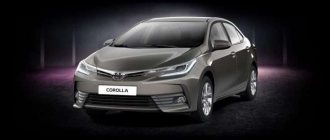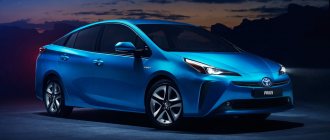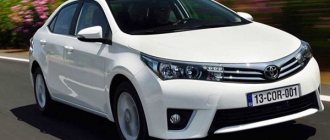The hybrid Toyota Prius was one of the first cars to combine a gasoline internal combustion engine and electric motors. The car is unusual, from the power plants to the transmission. The Toyota Prius received an automatic transmission, but it does not have a traditional and familiar gearbox for motorists - no hydraulic automatic, no CVT, no robot. Such units also cannot be found, for example, in trams, trolleybuses and other vehicles powered by electric traction. Hence, car owners have a completely logical question: “Is it worth servicing the gearbox on a Prius?” In this article we will answer a popular question and also talk about the resource of the hybrid transmission.
What does the Toyota Prius hybrid engine consist of?
In order to understand how the Toyota Prius hybrid works, you will need to familiarize yourself with the basic components of the installation. It includes a gasoline engine and two motor generators.
The operating principle of the internal combustion engine is based on the Atkinson cycle. AI-92 and AI-95 gasoline can be used as fuel. The power unit is distinguished by a reduced level of toxicity, economical consumption and high efficiency. The functionality of the planetary gear allows you to transmit torque to the wheels of the car, as well as ensure the operation of the motor-generator. This contributes to the generation of electrical energy to maintain the battery charge, the functioning of the air conditioning system and other electrical appliances.
Motor-generator No. 1 and No. 2
The first is designed to start the internal combustion engine, acting as a classic starter. It also ensures the operation of motor generator No. 2 when the battery charge decreases. Another function of electric motor No. 1 is to generate electrical energy to transfer charge to the battery.
The second motor-generator provides direct transmission of torque to the wheels, taking energy from the VVB.
The operating principle of Toyota Prius electric motors is based on the interaction of electromagnetic fields. For this purpose, powerful neodymium magnets are used in the rotor. The stator winding consists of copper conductors. The equipment can operate in two modes:
Generator - three-phase alternating voltage is supplied from the stator terminals. It is converted into a constant one through the use of a converter. Subsequently, the generated energy is used to maintain the operation of electrical equipment and charge the battery;
Motor - the motor-generator receives three-phase power to the stator winding, then the rotor begins to rotate. This occurs due to the interaction of magnetic fields. The result is kinetic energy.
Planetary "gearbox"
The complex design of the planetary mechanism ensures high-quality functioning of the hybrid installation. The gearbox is designed in such a way that it connects a gasoline unit solely to ensure the operation of the generator or rotation of the wheels. In this case, the latter mode is used only when the optimal speed of the 2ZR-FXE is reached. The indicated indicator is at the level of 2000 rpm.
The principle of distribution of the operation of Toyota Prius hybrid engines, thanks to the design of the planetary mechanism, is as follows:
- the vehicle moves at low speeds using electric power;
- To ensure speed gain and maintain it, additional energy is used from the generator, which is driven by the internal combustion engine.
In this case, the main feature of the planetary device is the absence of a direct connection between the gasoline unit and the wheel drive.
Classification by degree of electrification
Understanding the features of hybrid engines, we will also talk about the various applications of electric motors. The degree of electrification of a machine indicates the capabilities of the electrical installation. In one case, it comes as an app, in another it allows you to fully move on electric power. To understand how much progress has gone forward, let’s consider the stages of electrification sequentially.
Microhybrid
The microhybrid engine is the simplest form of hybridization. The car is equipped with a Start-Stop system, in which the electrical installation is used as a starter and generator, but does not transmit energy to the wheels. When the car is idling, the control unit turns off the gasoline engine, allowing you to save fuel. On average, consumption in the city is reduced by 10%.
The energy saved from regenerative braking powers the start-stop system and on-board devices.
A standard gearbox with a pulse oil pump is installed in the microhybrid power plant. In the "Start-Stop" mode, while the engine is not running, it is necessary to keep the switching elements turned on. The pump maintains oil pressure in the transmission channels so that after starting the engine, the car is ready to drive within 0.3 seconds.
Mild hybrid
The term “mild” or “moderate” hybrid means that the electric motor is used in cars as a light “support” for the internal combustion engine. The main work in acceleration and normal driving mode is performed by the gasoline engine. The essence of using an electric installation is to help when starting and accelerating the car, as well as to recharge the battery during braking. The electric motor power does not exceed 50 kW.
Similar article 1AZFE engine: resource, characteristics and problems
Hybrids of this type include: BMW 7 ActiveHybrid, Honda Civic Hybrid, Suzuki Smart Hybrid, Mercedes S 400 Hybrid.
Full hybrid
A full-fledged hybrid car is capable of running on one traction electric motor when the internal combustion engine is turned off. The electric motor replaces the clutch and works as a generator to charge the batteries, including in regenerative braking mode. Unlike a moderate hybrid, an electric motor with a power of 60 - 250 kW is used here.
The full hybrid principle is implemented in the Audi A1 and BMW X6 ActiveHybrid. Such hybrids are equipped with powerful lithium-ion batteries. However, with a capacity of 12 kW/h, the electricity storage device can provide a vehicle range of no more than 60 km. When the charge level is low, the internal combustion engine switches on automatically, but to reduce fuel consumption and increase the range of the electric motor, engineers developed Plung-In.
Hybrid plugins
Plung-In or hybrid plugin is similar in principle to a full hybrid. The difference lies in the ability to recharge the battery from an external network. The distance that a car can travel on electric power alone is characterized by the PHEV indicator.
To turn a hybrid engine into a Plung-In, additional equipment must be supplied: a charger, an additional control unit and a battery pack. The charging socket is located near the fuel tank filling flap. To recharge the battery, you can use your home power supply, taking into account the manufacturer's recommendations.
Description of the operating modes of the hybrid power plant
In this section, we will look at how the Toyota Prius hybrid installation works in various modes. Among them:
the beginning of movement with the start of the internal combustion engine;
electric start and high speed driving;
starting 2ZR-FXE on the go;
Start of movement with starting of the internal combustion engine
This mode is used when the battery charge is insufficient for starting a Toyota Prius from a standstill. In this case, the hybrid works as follows:
- Due to the action of generator motor No. 1, the planetary mechanism rotates, which starts the internal combustion engine;
- The internal combustion power unit begins to accelerate motor-generator No. 1, which is accompanied by the latter switching to generator mode. Next, the required amount of electrical energy is generated to charge the battery and ensure the operation of the second motor generator;
- 2ZR-FXE can work exclusively to ensure the operation of the first motor generator and maintain the required voltage in the Toyota Prius electrical network.
Electric start and high speed driving
The electric traction of the Toyota Prius hybrid installation operates when the car starts from a standstill in the following sequence:
- The ride begins with the gasoline unit turned off;
- Electric motor No. 2 drives the wheels and electric motor No. 1 through a planetary gear train. This process is provided by the stored energy of the battery. In this case, the voltage is converted from constant to alternating.
To ensure that the Prius moves at high speed when the permissible speed of electric motor No. 1 is reached, the following principle is used:
- Motor-generator No. 2 switches through gears to rotate the first one with a multiplicity of 2.6;
- This ensures a reduction in the rotation speed of electric motor No. 1 by 2.6 times relative to the second. The maximum permissible speed for the first electric motor is six thousand, reached at a speed of 64 km/h.
Prius a/v
The Prius α (Alpha) station wagon was introduced to the domestic market in the spring of 2011. The standard battery was replaced with a more compact lithium-ion one. The same car, but under the name Prius v, went on sale in the United States at the end of that year, and in the summer of the following year, 2012, it was introduced in Europe as Prius+.
Engines installed on Prius "alpha":
Engines installed on the Prius V:
Hybrid car device
Let's try to figure out how, with increased power, a car can consume gasoline at the level of a small car. The Toyota Prius hybrid car consists of:
- internal combustion engine (ICE);
- electric motor;
- planetary gearbox (power divider);
- generator;
- inverter;
- battery.
The internal combustion engine and the electric motor can operate simultaneously, alternately and complement each other if necessary. In a hybrid device, torque can be transmitted directly to the wheels from the electric motor and internal combustion engine in various proportions.
This is done using a planetary gearbox (power divider), which consists of a set of gears. Four of them are connected to a gasoline engine, and the outer one is connected to an electric motor. Another satellite is connected to a generator, which, if necessary, sends energy to the electric motor or charges the battery.
One of the main advantages of the Prius is that, unlike electric vehicles, charging a hybrid car does not require a power connection. The processor, which controls all the actions of the machine, recharges the battery from the internal combustion engine if necessary.
Types of hybrid units
Hybrid engines vary in type of application and layout. According to the first criterion, hybrids are divided into microhybrids, moderate hybrids and complete hybrids. We'll talk about them in more detail below.
The use of different layout systems of hybrid engines reflects the level of development of hybridization, the essence of which is the desire of manufacturers to convert the car to an alternative energy source. The most progressive companies in terms of development are Toyota, BMW, Hyundai, and Volvo.
How a hybrid car works
The main task of Toyota engineers was to create an economical car that would not be inferior to powerful “iron horses” on the track, but at the same time would have low engine consumption. For this, a combination of an internal combustion engine and an electric motor was used. To achieve maximum efficiency, in the Toyota Prius both power sources can operate separately, together and in parallel.
So, the operating principle of the hybrid Toyota Prius. The engine is started and the car accelerates using a traction electric motor. It rotates the external satellite of the planetary gearbox and thus transmits torque to the wheels. But you won't get far on a battery. Therefore, as soon as the car picks up speed, the internal combustion engine comes into play.
The combined use of an electric motor and an internal combustion engine makes it possible to achieve maximum efficiency (efficiency) of the entire system, because. When you press the brake, the internal combustion engine turns off and so-called regenerative braking occurs (all the energy from the resistance is converted into electricity), during which the electric motor, operating in generator mode, charges the battery.
If the car again requires increased power, for example for overtaking, the electric motor is switched on again, the energy of which is quite enough for a sharp increase in speed. The operation schemes of hybrid cars were designed to increase vehicle efficiency and reduce carbon dioxide emissions into the atmosphere. When fuel consumption increases (when you press the gas pedal), the control computer sends a signal to the power divider and turns on the electrical source, which allows the internal combustion engine to operate in no-load mode.
Prius PHV/Prime
In the summer of 2007, Toyota presented to the public a prototype called the Prius PHV (Plug-in Hybrid Vechicle), created on the basis of the classic second-generation model. The car received an enlarged battery, charged from an external power supply.
At the beginning of 2012, limited quantities of the “rechargeable hybrid” began to be offered in Toyota’s key markets: Japan, North America and Europe. The car could travel about 25 kilometers on electric power alone and was fully charged in just 1.5 hours.
An updated version of the Prius PHV, based on the classic fourth-generation model but with twice the lithium-ion battery, was introduced in February 2021. In electric mode, the new battery allowed a range of up to 68 kilometers. It was possible to bring its charge to the maximum from a household electrical outlet in the range from 2 to 14 hours. In North America, the Prius PHV is sold as the Prius Prime.
Engines installed on the Prius PHV:
Engines installed on Prius Prime:
Engine (ICE)
The Toyota Hybrid engine type is Hybrid Synergy Drive, which allows you to combine two power sources: an internal combustion engine and an electric motor. Let's find out what fuel engines are installed on the Prius.
In the mid-50s of the last century, engineer Ralph Miller proposed improving James Atkinson's . The essence of the idea was to increase the efficiency of the internal combustion engine by reducing the compression stroke. It is this principle, now often called the Miller/Atkinson cycle, that is used in Toyota hybrid engines.
So, Toyota Prius hybrid, how does the engine of this car work. Unlike other internal combustion engine models, the compression process in the cylinder does not begin at the moment the piston begins to move upward, but somewhat later. Therefore, before the intake valves close, part of the mixture of fuel and air is released back into the intake manifold, which allows you to increase the time in which the pressure energy of the expanding gases is used. All this leads to a significant increase in engine efficiency, increased unit efficiency, and also increases torque.
Engine characteristics:
- Volume - 1794 cc.
- Power (hp/kW/rpm) - 97 / 73 / 5200.
- Torque (Nm/rpm) - 142/4000.
- Fuel supply - injector.
- Fuel - gasoline AI 95, AI 92.
The consumption of the Toyota Prius hybrid per 100 km in the urban cycle is 3.9 liters, on the highway - 3.7 liters.
Changing the oil in the box
To change the oil in a planetary gearbox, you will need original Toyota ATS WS lubricant or a high-quality analogue, for example, Idemitsu ATF Type TLS-LV. The original material will cost about 400 rubles per 1 liter. Article number for purchase - 0888680807. The topic of choosing gear oil for a box has always been relevant. Drivers usually do not know which brand of product is best to purchase - original or non-original.
Idemitsu ATF Type TLS-LV oil is a complete analogue of the original Toyota ATS WS; in formulation and composition it is as close as possible to the lubricant recommended by the manufacturer itself. To order one liter of oil in the online store, use article number 30040096-750. Approximate cost: 550 rubles.
You will also need:
- sealing washers (90430-18008) for the drain and filler plug;
- When unscrewing the drain plug, the edges may be damaged, so it is best to purchase a new copy in advance (part number 90341-18051).
You can do all the work of replacing the ATF yourself; everything is quite easy and simply unscrewed. In addition to new ATF oil, you also need to equip yourself with the following tools:
- 10 mm hex key;
- 10 mm head;
- clip remover;
- hose at least 1 m;
- funnel and rags optional.
You need to drain the old oil from the box by first unscrewing the two plugs. After that, take a hose 1 m long and with an outer diameter of no more than 16 mm. The hose is pulled through and the funnel is fixed, then new liquid is poured. The total filling volume is approximately 3.7 liters; if you jack up the car, all 4 liters will fit due to the resulting tilt. Next, all that remains is to change the sealing washer of the transmission filler plug and insert it back into place. Using a rag, carefully wipe away any traces of fluid leaks and screw in the filler plug.
Toyota car electric motor
The design of the hybrid synergetic drive involves the use of a traction electric motor. The power of the Toyota Prius electric motor is 56 kW, 162 Nm. This unit ensures that the car moves from the start until it reaches a constant speed; it turns on when the car is overtaking and participates in braking. The entire Toyota Prius system is thought out to the smallest detail. Charging of a hybrid car is carried out while driving, from the internal combustion engine through a control generator.
2ZR-FXE
The first engine in the 2ZR line was released in 2007. The power unit with the 2ZR-FXE index has been produced since 2009 in China and the USA. The motor is an analogue of the 2ZR-FE, but is intended for installation on hybrid cars. Just like 1NZ-FXE, the internal combustion engine operates on the Atkinson cycle.
Compared to the third-generation Prius, for which the 2ZR-FXE was developed, the engine was completely redesigned for 2011 to deliver significantly better fuel economy. The unit featured a lot of innovations and improvements that had never been seen before in all the years.
By the way, in the Chinese market 2ZR-FXE is offered under the indexes - 5/8ZR-FXE.
| 2ZR-FXE | |
| Volume, cm3 | 1797 |
| Power, hp | 95-99 |
| Consumption, l/100 km | 1.7-5.6 |
| Ø cylinder, mm | 80.5 |
| SS | 13 |
| HP, mm | 88.4 |
| Models | Auris; C-HR; Corolla; Esquire; Noah; Prius (a, PHV, Prime, v); Voxy |
| Resource, thousand km | 250+ |
Typical malfunctions of 1NZ-FXE and 2ZR-FXE engines
As for the typical malfunctions of this Toyota engine, it is worth saying that if even one of the many sensors fails, the power plant completely stops working. Naturally, diagnosing such a problem is not at all easy.
Also among the disadvantages we can mention such problems as: premature failure of the flywheel; a chain that tends to stretch; The alternator belt also wears out quickly. The remaining disadvantages of the installation are strictly individual and depend on the regularity of maintenance, as well as on the quality of the fuel and oil.
Extraneous noise at medium speeds is also not uncommon for the 2ZR-FXE. The most common cause is a weakened timing chain or a worn alternator belt. If the cause of unnatural sounds is identified, the drive parts should be tightened or replaced.
Floating idle speed most often indicates a malfunction of the damper.
Sometimes, in addition to cleaning the throttle body, you may need to check the sensors. In addition, often after 50 thousand km. mileage, the pump may begin to leak. It is better to replace it as soon as possible, otherwise the thermostat may fail, due to which the engine will not warm up to the required temperature, and this may contribute to valve jamming.
Accumulator battery
The hybrid is equipped with two batteries (main high-voltage and auxiliary), both are located in the trunk of the car. The main device of the car battery is made of nickel-metal hydride alloy and has a capacity of 6.5 A/h, voltage 201.6 V. This unit has its own cooling system. Inside the high-voltage battery there is a controller that controls the charging process of each cell (block) of a total of 168 cells.
The consumption and recovery of battery energy is controlled by the vehicle's control processor. The Toyota Prius battery does not require recharging from the electrical network; this process is carried out while the vehicle is moving and braking (for the most part). Auxiliary battery: 12 V (35 Ah, 45 Ah, 51 Ah).
Conclusion
Despite the fairly high cost, hybrid cars are attracting more and more interest among buyers. Compared to other hybrid cars, the Toyota Prius actually consumes significantly less fuel and has low carbon dioxide emissions.
The Toyota Prius hybrid model has been so improved over its three generations that today this power unit can be found in a number of more popular mass-produced Toyota models. So what is the design know-how of the Toyota hybrid?
Toyota's hybrid powertrain includes an internal combustion engine, two electric motors and a planetary gear.
Design
The hybrid power plant of the Toyota Prius is a series-parallel design (combined), in which torque can be transmitted to the wheels from the internal combustion engine directly and from the traction electric motor in any proportions. To implement work according to this scheme, a so-called power divider was introduced into the design of the power plant. This is a planetary mechanism with four satellite gears. A traction motor is connected to the outer gear of this mechanism. It is also directly connected to the main gear, which transmits torque to the cross-axle differential and then to the wheels. The four satellites in this design are connected to the internal combustion engine, i.e. their axes rotate around the axis of the central sun gear. The latter, in turn, is connected to the control motor-generator. To understand how this design works, you should consider its operating modes separately.
Repair of planetary gearbox
The Toyota Prius transmission does not require special maintenance and care; in general, prices for consumables are affordable, and finding a suitable transmission oil along with a filter is not a problem today. But even with high-quality and timely maintenance, breakdowns may occur from time to time. One of the most common reasons why motorists turn to a service station for professional help is the strange sounds that the car makes while driving.
Often the cause of excessive noise lies in a worn bushing or tapered bearing support ring. In this case, you must immediately go to a service station to diagnose the unit. A preliminary diagnosis of the gearbox can be made by removing the pan. Abundant amounts of magnetic and non-magnetic wear debris will indicate mechanical wear of internal components. You can't do without repairing the box. Sometimes there is a need for a new gearbox, since there is no point in repairing the old one. For a contract box in good condition you will have to pay about 50 thousand rubles.
Toyota Prius transmission
The latest Toyota Prius update makes the transmission more compact and efficient
edit this post
Specifications
The Toyota Prius XW10 had good technical characteristics and during the first testing (only the first!) evoked enthusiastic responses from experts and journalists.
Dimensions
Prius 10 had the following characteristics:
- body dimensions (mm) – length (4275), width (1695) and height (1490);
- dimensions of a five-seater cabin with two rows of seats - length (1850), width (1400) and height (1250);
- ground clearance – 140 mm;
- wheelbase – 2550 mm;
- turning radius (minimum) – 4.7 m;
- Tank volume – 50 l (when filled).










